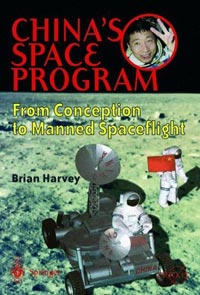China’s Space Program

Review: China’s Space Program
by Jeff FoustMonday, August 22, 2005
China’s Space Program: From Conception to Manned Spaceflightby Brian HarveyPraxis, 2004softcover, 350 pp., illus.ISBN 1-85233-566-1US$34.95
Some time in the next two months, in all likelihood, China will launch Shenzhou 6, its second manned mission. Like the Shenzhou 5 flight two years ago, this mission will capture the world’s attention for at least a brief time, and be the focus of intense speculation about China’s future plans in space. Some of that speculation will claim that China’s manned spaceflight plans will create a new “space race” with the United States to see who will be the first to land humans (back) on the Moon. Indeed, that has already started: Newsday columnist James Pinkerton suggested earlier this month that “soon enough, it will become apparent that the Chinese are serious about space exploration, including colonization of the moon” and that “when we realize that a new rival is beating us, we will get moving again and start competing to get our kind to the moon.” Such claims are hard to justify given the glacial progress of the Chinese space program, which has launched less than 100 missions since its first satellite launch in 1970. (See “The phony space race”, The Space Review, June 9, 2003.) By the same token, though, Chinese progress to date cannot be written off: it takes considerable technical expertise to safely fly humans in space.
What complicates analysis of Chinese space efforts is the lack of freely available information about the Chinese space program. Few Chinese launches are announced in advance, and proposals by individual scientists and engineers for future missions are often conflated with actual government-approved missions. This leads to reports like a Reuters article earlier this week that breathlessly proclaimed that China would launch its first lunar orbiter mission in 2007, an announcement that was hardly news since Chinese officials had been saying the same thing for many months. Brian Harvey makes a noble effort to rectify this problem by shedding some light on Chinese space efforts and providing some crucial historical background in his book China’s Space Program.
China’s Space Program is perhaps the best single-volume summary of Chinese space efforts, at least among those written in English.
China’s Space Program starts with a detailed narrative of the flight of Shenzhou 5, from the pre-launch preparations through the actual mission to the safe recovery of Yang Liwei. Harvey then provides a detailed history of Chinese space efforts, which began in earnest when the Chinese-born, American-educated scientist Tsien Hsue Shen returned to China in the 1950s, a victim of McCarthy-era persecution for alleged communist ties. Tsien and other Chinese engineers (many of whom were also graduates of American universities) embarked on a series of efforts to develop guided missiles and, later, satellite launch vehicles. This culminated in the successful launch of China’s first satellite, Dong Fang Hong (“East is Red”), in 1970.
Harvey’s book is not a strictly chronological account of the history of China’s space program: after examining the early history of China’s program, various chapters explore in detail satellite and launch vehicle development, China’s foray into the commercial launch market (and the technology transfer controversy with the US in the late 1990s that effectively shut down those efforts), the various organizations and facilities used by the program, and, of course, the development of a manned program, including an abortive attempt to develop human spaceflight capability in the early 1970s, just a few years after China launched its first satellite. Not surprisingly, a final chapter examines the future of China’s space program, including a potential space station and robotic (but not human) missions to the Moon and even Mars. (This makes the cover which purports to show a manned Chinese lunar mission, complete with a rover that prominently displays the word “China” in several places, a bit misleading.)
China’s Space Program is perhaps the best single-volume summary of Chinese space efforts, at least among those written in English. The book is thoroughly researched, with references at the end of each chapter and an extensive bibliography at the end. (Harvey appears to limit himself primarily to English-language sources for his research; it’s not clear how limiting the exclusion Chinese-language sources is, given the tight control the government puts on the release of any information on the program.) The book contains many photos and illustrations from Chinese and Western sources. Unfortunately, some of them have the fuzzy, muddy look of low-resolution images pulled from the Web.
While published a year ago, China’s Space Program is still very relevant: the book is only missing some additional details about the Chang’e lunar exploration program and the upcoming Shenzhou 6 mission that have been revealed in the last 12 months. That makes this book just as timely as ever: with Shenzhou 6 to launch in the coming weeks, a book like this offers the reader a better perspective on China’s space program and helps to weed out the hype and hysteria that is sure to follow the mission in the media.
Jeff Foust (jeff@thespacereview.com) is the editor and publisher of The Space Review. He also operates the Spacetoday.net web site and the Space Politics weblog. Views and opinions expressed in this article are those of the author alone, and do not represent the official positions of any organization or company, including the Futron Corporation, the author’s employer.

0 Comments:
Post a Comment
<< Home